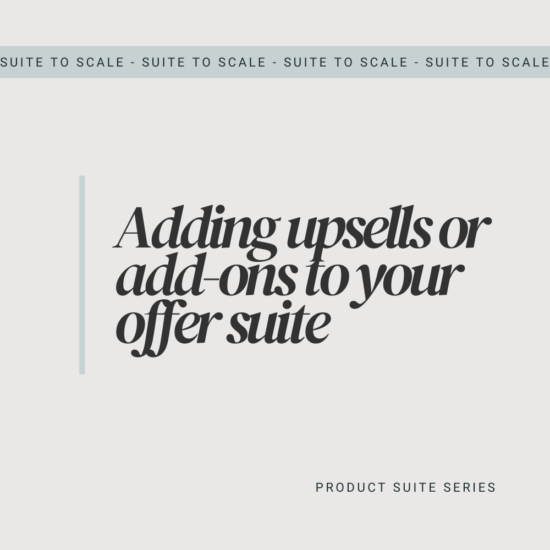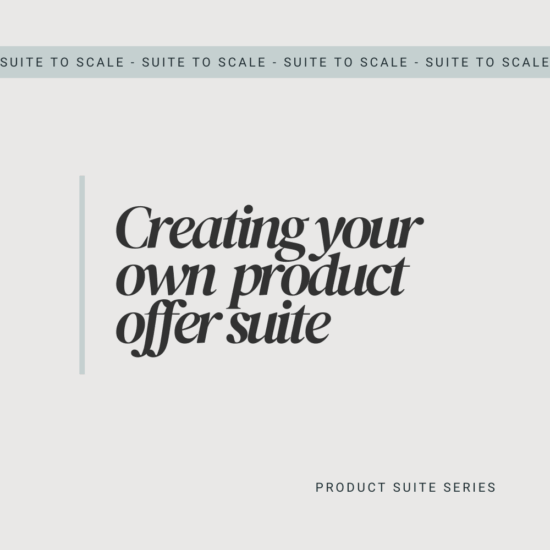Quick Summary: This blog post explores three popular scalable offer types for service-based business owners: online courses, memberships, and templates/digital downloads. It outlines who each offer is best suited for, how they’re typically built and supported, what it takes to succeed with each, and includes real-life examples and practical tips for getting started.
You’re fully booked. You’ve built a service business you’re proud of.
But lately, you’ve been thinking…
“How do I grow this without working more hours?”
If that sounds like you, you’re not alone. Scaling beyond 1:1 work is the dream.
Choosing the right way to do it? That’s where most service providers get stuck.
- Should you create a course?
- Launch a membership?
- Sell a set of templates?
This post will break down the pros, cons, and use cases of three popular scalable offers, and help you figure out which one fits your business best.
Why a scalable offer matters:
When you rely solely on 1:1 services, your income is tied to your time.
Scalable offers unlock growth by letting you:
- Serve more people without working more hours
- Productize your expertise into repeatable assets
- Build income streams that keep growing (even when you’re offline)
But not all offers are created equally and not every offer is right for every business.
Let’s walk through the most popular ones and see what fits.
Option 1: Online courses
Online courses are best for you if:
You have a repeatable process or step-by-step transformation you guide clients through.
Courses allow you to package your process into a self-paced experience (or a hybrid with live support). You can teach once, and enroll clients again and again.
Pros:
- High earning potential
- Builds your authority and brand
- Can be automated or launched multiple times
- Allows you to serve more people without more time input
What to watch out for:
- Requires upfront time to build.
Consider pre-selling to validate your idea before investing time. - Needs solid audience trust or launch strategy.
Start building your email list or social following early to establish trust and interest. - If support isn’t structured properly it can become overwhelming.
Don’t copy other people’s support processes. Figure out what your students need, what you can give, and what your pricing should look like to make it work.
- Requires upfront time to build.
Course Example:
A copywriter turns her signature sales page method into a self-paced course with plug-and-play copy templates.
Things to Know About Online Courses:
If you’re used to delivering everything 1:1, the idea of creating a course might feel overwhelming or rigid.
But here’s the truth:
🧁 Courses come in all shapes and sizes.
And there’s no one “right” way to build or deliver them.
You can create a course that fits your style, your audience’s needs, and your bandwidth.
It might look like:
- Pre-recorded video lessons
- Text-based modules with worksheets
- Audio trainings paired with templates
- A series of emails with bite-sized actions
- A mix of all of the above
Courses live inside platforms like:
- *Thrivecart Learn
- *Teachable
- *Thinkific
- Slack
- Notion
- Skool
You get to choose the delivery method that works best for you and your students.
🧁 And when it comes to support? You have options:
- Email access or a feedback form
- A private Facebook or Circle group
- A weekly live Q&A (if that fits your energy)
- An FAQ section with access to a question form
- No support if your course stands strong on its own
- Time specific support (access to a question form for 3 months)
The key to success with a course isn’t the platform or polish, it’s alignment.
Here’s what truly makes a course successful:
✅ A clear problem that your audience is actively trying to solve.
No need for a massive audience, just people who want the solution.
✅ A course structure that’s easy to follow and implement.
Students should know what to do and feel momentum quickly.
✅ A transformation that’s worth paying for.
If someone’s willing to invest their time and money, you’ve hit the sweet spot.
✅ Consistent, aligned marketing.
You’re not just selling features, you’re addressing their pain points, goals, and hesitations.
💡 Pro Tip:
Don’t build the whole course before you sell it.
Pre-sell it first → get those payment notifications → and then co-create the first version with your students.
This gives you:
- Real-time feedback from actual buyers
- Confidence that the offer works
- A built-in testimonial pipeline for your next launch
You don’t need to go all in on a 10-module behemoth. You just need to package your process into a path your students can walk without you needing to guide every step 1:1.
Suite to Scale Newsletter:
Get expert tips every Wednesday on product suite creation, sales funnels, and impactful program design—all tailored for service business owners like you.
Option 2: Memberships
Memberships are best for you if:
You want to provide ongoing support, fresh content, or foster a community.
Memberships are perfect for creators who love showing up consistently and want to build monthly recurring revenue.
Memberships work well if the content you’re trying to teach changes or updates often.
Pros:
- Predictable, recurring income
- Deeper connection with your audience
- Easier entry point for new buyers
- Easier to share updated information
What to watch out for:
- Ongoing content expectations can burn you out.
- Churn rate can be tricky without value delivery systems.
Churn rate: the percentage of members that cancel or stop renewing their membership.
Reduce churn rate by getting feedback on what your members need/want. - Audience can get overwhelmed if there is no clear path for new members.
Membership Example:
A marketing strategist launches a low-ticket monthly membership with trend breakdowns, content calendars, and monthly group Q&As.
Things to Know About Memberships:
If you’re looking for recurring revenue, a membership can sound like a dream, but it’s also a relationship.
And like any good relationship, it needs structure, commitment, and clear communication.
🧁 Memberships come in all shapes and sizes.
There’s no perfect formula, just the model that fits you, your energy, and your audience.
A membership might include:
- Video lessons or short audio trainings
- Templates, workbooks, or resource drops
- Live calls, Q&A sessions, or guest trainings
- Written lessons delivered via email, Slack, or Discord
- A supportive community or accountability space
- Or some magical mix of the above
And the delivery? That’s up to you too:
- Maybe it’s hosted on a platform like Circle, Skool, or *Thinkific
- Maybe you run it through a private Slack group with links to resources
- Maybe your members get weekly emails with tips + templates
🧁 Support can look different too:
- A private community with group check-ins
- Office hours on Zoom or async voice replies
- A shared FAQ doc or Google Form to collect questions
- Or no support at all, if the content stands on its own
The success of a membership isn’t based on how much you offer, it’s how clearly you deliver ongoing value.
Here’s what makes a membership successful:
✅ A focused, recurring problem your audience wants help solving.
✅ An audience large enough to make recurring revenue worth your time.
✅ A simple, repeatable structure that builds trust.
✅ A system for engagement that reduces churn.
✅ Time and energy to show up consistently, even if it’s in a lightweight way.
💡 Pro Tip:
Start with a lean version.
Build the rhythm, gather feedback, and expand only if it’s sustainable.
A strong membership doesn’t mean more content, it means more intentional support delivered in a way your audience wants, and that you can deliver without burning out.
Option 3: Templates & digital products
Digital products are best for you if:
You want a quick win and love creating tools or resources.
Templates (or digital products) are ideal for helping your audience take action fast.
They’re usually lower-priced, but they convert well and can be the perfect intro to your brand.
Pros:
- Quick to create and sell
- Doesn’t require live delivery or ongoing support
- Great as an entry product in your offer ladder
What to watch out for:
- Lower price = needs higher volume to scale
- Can get lost in a sea of freebies without strong branding or positioning
Digital Product Example:
A Pinterest manager sells plug-and-play client strategy templates to other service providers.
Things to Know About Templates & Digital Products:
Templates and digital products are often seen as the “easy win” for scaling but success doesn’t come from slapping a Canva file on your website and hoping for the best.
🧁 There’s no single “right way” to create or deliver a digital product.
And that’s the beauty of it.
You get to design something simple, helpful, and scalable.
Your template or digital product could be:
- A single-page PDF or full workbook
- A Google Doc, Sheet, or Notion template
- A Canva template bundle or swipe file
- A mix of text, visuals, video, or even audio
Delivery can be just as flexible:
- Instant download from your website
- Email delivery through your welcome sequence
- A gated folder or private page for access
- Even a “delivery” post in a social media group
🧁 Support? Totally optional.
You could offer:
- A quick-start guide inside the file
- A follow-up email with tips + FAQs
- An open email for support questions
- Or no support at all (yes, really)
The key to success with templates isn’t the forma, it’s how well they solve a specific, time-sensitive problem.
Here’s what makes templates + digital products successful:
✅ They solve a problem your audience already knows they have.
Think: “I need a better onboarding workflow”
Not: “I need to rethink my entire backend”
✅ You have a growing or consistently refreshed audience.
They work best when you’ve got visibility or a solid paid traffic strategy.
✅ You focus on customer lifetime value (LTV).
Use upsells, cross-sells, bundles, and funnels to turn one sale into multiple.
✅ You offer variety and stackable solutions.
When your templates work together, customers come back for more.
✅ You have a traffic plan.
Pinterest ads, email funnels, and evergreen content can keep your funnel full.
💡 Pro Tip:
If you’re not seeing consistent sales from one template: ask if the problem is clear, not the product.
Your best-selling templates will always be the ones that feel like a shortcut, solve a specific pain point, and help your audience say, “Finally… this is exactly what I needed.”
How to choose the right scalable offer for you:
Still unsure? Ask yourself:
- Do I love teaching?
→ You might love a course or group program. - Do I want steady, monthly income?
→ Memberships can create predictable revenue. - Do I want to start small and test the waters?
→ Templates are a great first step.
You can also take the pressure off by remembering:
This isn’t your forever offer.
It’s just your next step.
Can you combine these offers?
Absolutely. Many business owners create an offer suite over time:
- Templates as a low-cost entry point
- A course as your signature product
- A membership as an ongoing support space
This layered model builds stability, flexibility, and income diversity, all while staying aligned with your zone of genius.
Other business owners start with:
- A template they already have that clients want
- Then realize they create new templates for themselves monthly and offer that as a membership drop to clients
There is no right way to create your offer suite.
My Thoughts:
Scaling doesn’t have to mean building a 20-module course or managing a giant community.
The best scalable offer is the one you can actually launch.
Focus on something you can create in the next 30 days.
Test it, refine it, and grow from there.
You don’t need to do it all, just one step at a time.
- Courses are great for teaching your proven process.
- Memberships work if you love community and consistency.
- Templates are perfect for fast-action support and lower-effort sales.
Choose the one that feels doable and aligned, not the one that looks the fanciest.
You’ve already built something amazing.
Now it’s time to scale it, sweetly. 🍬
Your next step:
👉 Read the Product Suite Guide for a breakdown of all your scalable offer options.
👉 Join the Suite to Scale newsletter for weekly tips on creating an offer suite, sales funnels, and systems that scale sweetly.
*Affiliate Links: I may receive a commission if you purchase using one of my links (at no cost to you).







